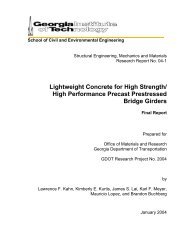Special-Uses-Alkali - Expanded Shale & Clay
Special-Uses-Alkali - Expanded Shale & Clay
Special-Uses-Alkali - Expanded Shale & Clay
Create successful ePaper yourself
Turn your PDF publications into a flip-book with our unique Google optimized e-Paper software.
APPENDIX B: FMC-EUCLID CHEMICAL ADDITIONAL TESTING RESULTSWhile soliciting other vendors to participate in this study, FMC-Euclid Chemical submitted their lithiumproduct to be included in this study. The original scope of this study was to have the mortar barexpansion readings taken up to 14 days without any modifications to the test procedure, FMC-EuclidChemical requested modifications to the test procedure to properly test its product. FMC – Euclid alsorequested all the tests be measured at 28 days. This provided a comparison to the Federal AviationAdministration (FAA) data requiring 28-day expansion readings. FMC-Euclid Chemical paid to haveall the test results taken up to 28 days. This was done to provide a uniform knowledge base for all theproducts in the study.The lithium admixture was used in dosage rates of 50%, 100% and 150%. These rates correspond to thetotal amount of alkali equivalent within the cement. These bars seemed to exhibit a lower strength, notedby some broken bars when removed from the molds. The bars were then placed in a sodium hydroxidesoak solution modified with lithium nitrate with 40 grams (g) of lithium nitrate per liter of the requiredstrength of sodium hydroxide (NaOH) solution. The soak solution has to be modified when testing isperformed on specimens containing lithium because the lithium in the specimens will tend to migratetowards the lower concentration in the soak solution and leach out of the bars. A gel came out of thebars within a few days of being in the soak solution; this made the bars somewhat slick on the outside.The specimens at 50% dosage showed 0.09% expansion at 14 days, the 100% dosage rate had anexpansion of 0.01%, and the 150% dosage had 0.00% expansion at 14 days. These expansions stayedlow even through 28 days, with expansions of 0.17%, 0.02%, and 0.00% for the dosage rates of 50%,100% and 150% respectively.The mix design for the lithium was performed at the 50% dosage rate because of the 0.09% expansion at14 days. This mix was very workable and had a higher slump. While finishing, it was noted that therewas more bleed water on these specimens than any other. The slump was 5.0 inches with an air contentof 4.3% and a unit weight of 142.4 pcf. The compressive strengths for the mix were low with values of2,670 psi, 4,420 psi, 5,380 psi for 7, 28 and 56 days respectively. The average rapid chloridepermeability reading of the two 28-day specimens was 4,077 coulombs.B-1















